|
Location: Nuffar, Afak, Iraq. |
Grid Reference:
32� 7' 37' N, 45� 14' E. |
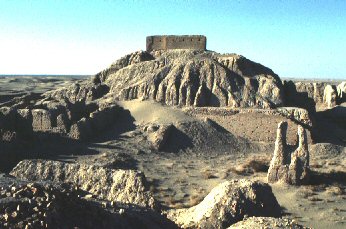
 Nippur:
(Sumerian City).
Nippur:
(Sumerian City).
Sumerian:
Nibru; Akkadian: Nibbur, from the Sumerian for 'lord
wind' (Enlil), is modern Nuffar in Afak (Al-Qādisiyyah)
During its peak, at around 2500 B.C, Nippur boasted
multiple large temples, government buildings and businesses. Its
inhabitants were very literate for the time - over 40,000 inscribed clay
Sumerian and Akkadian tablets have been found there, bearing all from epic
tales such as the Creation Story to legal documents, medical records and
school texts. Powerful trading connections have been revealed in the range
of objects originating from such other civilizations as Babylonia, Egypt,
Persia, the Indus Valley, and Greece.
Nippur was one of the most ancient and
sacred of all the Sumerian cities. It was the special seat of the worship
of the Sumerian god, Enlil, ruler of the cosmos
(Click here for Map of
site)
|
Nippur:
(The 'Temple of
Enlil') |
Founded in about 5000 B.C., (1)
Nippur is an
ancient city in Mesopotamia in an area now part of south-eastern Iraq,
south of Baghdad. Nippur was an important city for religious reasons,
since it was the home of the supreme god and creator of mankind, Enlil,
a storm god, for whom a ziggurat and temple were built. Additionally,
whoever controlled Nippur could claim the politically important title of
King of Akkad and Sumer. Tens of thousands of Sumerian and Akkadian
tablets have been found in Nippur.
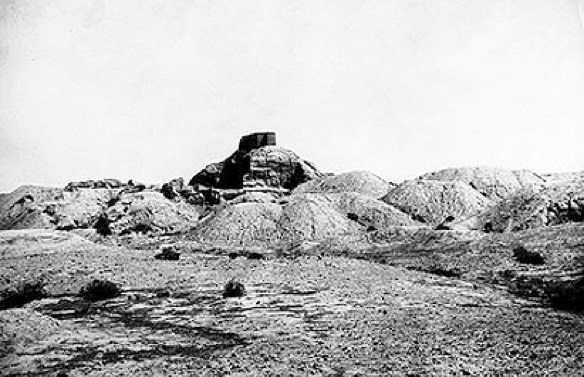
The ruins of Nippur, among the largest in
southern Mesopotamia, cover approximately 180 acres. They are divided
into two well-nigh equal parts by the now dry bed of the Shatt-en-Nil, a
canal which at one time branched off from the Euphrates and watered the
otherwise barren territory through which it flowed. The eastern half
contains the temple structures, including the ziggurat and the group of
buildings which must have formed the scribal school and library; it is
in this part of the mound that the "tablet house" was excavated. The
western half seems to mark the remains of the city proper.
Nippur was situated on
both sides of the Shatt-en-Nil canal, one of the earliest courses of the
Euphrates, between the present bed of that river and the Tigris, almost
160 km southeast of Baghdad. It is represented by the great complex of
ruin mounds known to the Arabs as Nuffar, written by the earlier
explorers Niffer, divided into two main parts by the dry bed of
the old Shatt-en-Nil (Arakhat). The highest point of these ruins, a
conical hill rising about 30 m above the level of the surrounding plain,
northeast of the canal bed, is called by the Arabs Bint el-Amiror
"prince's daughter."
Enlil is associated with the ancient
city of Nippur, and since Enlu with the determinative for "land" or
"district" is a common method of writing the name of the city, it
follows, apart from other evidence, that Enlil was originally the patron
deity of Nippur.
At a very
early period - prior to 3000 BC - Nippur had become the centre of a
political district of considerable extent. Inscriptions found at Nippur,
where extensive excavations were carried on during 1888-1900 by Messrs
Peters and Haynes, under the auspices of the University of Pennsylvania,
show that Enlil was the head of an extensive pantheon. Among the titles
accorded to him are "king of lands," "king of heaven and earth" and
"father of the gods".
His chief
temple at Nippur was known as E-kur, signifying 'House of the mountain',
and such was the sanctity acquired by this edifice that Babylonian and
Assyrian rulers, down to the latest days, vied with one another in
embellishing and restoring Enlil's seat of worship, and the name Ekur
became the designation of a temple in general.
Grouped
around the main sanctuary, there arose temples and chapels to the gods
and goddesses who formed his court, so that E-kur became the name for an
entire sacred precinct in the city of Nippur.
The name
"mountain house" suggests a lofty structure and was perhaps the
designation originally of the staged tower at Nippur, built in imitation
of a mountain, with the sacred shrine of the god on the top.
When, with
the political rise of Babylon as the centre of a great empire, Nippur
yielded its prerogatives to the city over which Marduk presided, the
attributes and the titles of Enlil were largely transferred to Marduk.
But Enlil
did not, however, entirely lose his right to have any considerable
political importance, while in addition the doctrine of a triad of gods
symbolizing the three divisions - heavens, earth and water - assured to
Enlil, to whom the earth was assigned as his province, his place in the
religious system.
It was no
doubt in part Enlil's position as the second figure of the triad that
enabled him to survive the political eclipse of Nippur and made his
sanctuary a place of pilgrimage to which Assyrian kings down to the days
of Assur-bani-pal paid their homage equally with Babylonian rulers.
The
Sumerian ideogram for Enlil or Ellil was formerly incorrectly read as
Bel by scholars, but in fact Enlil was not especially given the title
Bel 'Lord' more than many other gods.
The
Babylonian god Marduk is mostly the god persistently called Bel in late
Assyrian and Babylonian inscriptions and it is Marduk that mostly
appears in Greek and Latin texts as Belos or Belus. References in older
literature to Enlil as the old Bel and Marduk as the young Bel derive
from this error in reading.
|
The "Tablet House".
The Nippur expedition
succeeded in excavating approximately thirty thousand tablets and
fragments in the course of its four campaigns, the larger part of which
are inscribed in the Sumerian language and date from the second half of
the third millennium to the first half of the second millennium B. C.
The contents of
these tablets are rich and varied. The greater part is economic in
character; it consists of contracts and bills of sale, promissory notes
and receipts, lists and accounts, wills, adoptions, court decisions, and
other legal and administrative documents. Many of the tablets are
letters; some are historical inscriptions; still others are lexical in
character, that is, they contain Sumerian dictionary and grammatical
material of priceless value for our study of the language, since they
were actually compiled by the ancient scribes themselves. But especially
noteworthy is the large group of tablets dated about 1750 B. C. a
which are inscribed with the Sumerian literary compositions consisting
of epics and myths, hymns and laments, proverbs and "wisdom."
But of the Nippur literary tablets
excavated by the University of Pennsylvania and now located in Istanbul
and Philadelphia, some two thousand in number, only about five
hundred have been copied and published to date. And while all of the
approximately seven hundred pieces in the British Museum, Louvre, Berlin
Museum, and Ashmolean Museum have been copied and published, 12
some of the more important texts did not appear until a relatively
recent date.
The Nippur Tablet.
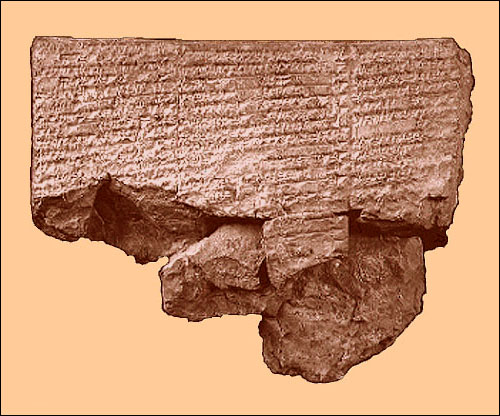
THIS clay tablet from ancient Nippur
is the only surviving document of the Sumerian flood story. Dating
from the 17th century BC, the tablet contains six columns of text,
three per side, with 10-15 lines in each column. Written in Sumerian,
it not only tells the flood story, but also describes the creation of
humans and animals, and records the names of antediluvian cities and
their rulers.
After Anu, Enlil, Enki, and Ninhursag
had fashioned the black-headed people,
Vegetation sprang from the earth,
Animals, four-legged creatures of the plain,
Were brought artfully into existence
[37 lines are unreadable]
After the....of kingship had been lowered from heaven
After the exalted crown and the throne of kingship
Had been lowered from heaven,
He perfected the rites and exalted the divine
ordinances...
He founded the five cities in pure places,...
Then did Nintu weep like a....
The pure Inanna set up a lament for its people,
Enki took council with himself,
Anu, Enlil, Enki, and Ninhursag....
The gods of heaven and earth uttered the name of Anu and
Enlil
Then did Ziusudra, the king, the priest of...,
Build a giant...;
Humbly obedient, reverently he...
Attending daily, constantly he...,
Bringing forth all kinds of dreams, he...,
Uttering the name of heaven and earth, he...[...]
the gods a wall...,
Ziusudra, standing at its side, listened.
"Stand by the wall at my left side...,
By the wall I will say a word to you,
Take my word,
Give ear to my instructions:
By our...a flood will sweep over the cult-centers;
To destroy the seed of mankind...,
Is the decision, the word of the assembly of the gods.
By the word commanded by Anu and Enlil...,
Its kingship, its rule will be put to an end.
[about 40 lines missing]
All the windstorms, exceedingly powerful,
Attacked as one,
At the same time, the flood sweeps over the cult-centers.
After, for seven days,
the flood sweeps over the cult centers.
After, for seven days and seven nights,
The flood had swept over the land,
And the huge boat had been tossed
About by the windstorms on the great waters,
Utu came forth, who sheds light on heaven and earth,
Ziusudra opened a window of the huge boat,
The hero Utu brought his rays into the giant boat.
Ziusudra, the king,
Prostrated himself before Utu.
The Sumerians formulated lists of their ancient kings, and
gave them extremely long reigns. The time before the flood
was said to be a period of 432,000 years. Two kings from
after the flood that are listed were Gilgamesh and Tammuz.
Legends told about these two kings were so impressive that
Tammuz entered the pantheon of Babylon and later became
known as Adonis to the Greeks.
Gilgamesh became the hero of the Babylonian
epic poem which bears his name, and which also contains an
account of the flood. Until recently, these king lists and
the names in them were thought to be purely fanciful. But in
the 1930's, Sir Leonard Woolley, while excavating a building
at Ur on the Ubaid level, found an inscription indicating
that the structure had been erected by the son of the
founder of the First Dynasty of Ur, a person up till that
time regarded as fiction. Gilgamesh, too, has been found to
be a real person, with inscriptions telling of the buildings
he built.
Babylonian
Cartography
Ur-Gur also rebuilt the
walls of the city in general on the line of Naram-Sin's walls. The
restoration of the general features of the temple of this and the
immediately succeeding periods has been greatly facilitated by the
discovery of a sketch map on a fragment of a clay tablet.
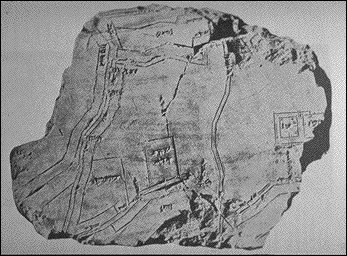
This
sketch map represents a quarter of the city to the eastward of the Shatt-en-Nil
canal, which was enclosed within its own walls, a city within a city,
forming an irregular square, with sides roughly 820 m long, separated
from the other quarters of the city, as from the surrounding country to
the northand east, by canals on all sides, with broad quays along the
walls. A smaller canal divided this quarter of the city itself into
twoparts, in the south-eastern part of which, in the middle of its
southeast side, stood the temple, while in the northwest part, along the
Shatt-en-Nil, two great storehouses are indicated. The temple proper,
according to this plan, consisted of an outer and innercourt, each
covering approximately 8 acres (32,000 m�), surrounded by double walls,
with ziggurat on the north-western edge of the latter.
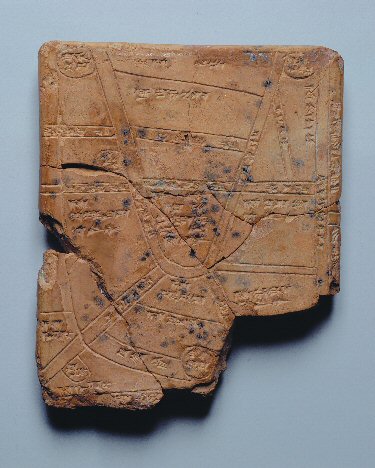
This ancient clay tablet is dated to
the 14th-13th century BCE, and on it is inscribed a map of the
countryside around the Mesopotamian city of Nippur, located in the
middle of the southern Mesopotamia floodplain, near the modern city of
Diwaniyah. The inscription on the tablet is in cuneiform.
(Other
Examples of Prehistoric Cartography) |
Sargon of Akkad may
have been the world's first empire-builder. Legend states that he was
found floating in a basket and brought up by a gardener. Later it is
known he became a cupbearer to King Ur-Zazaba of Kish in Sumer. Sargon
rose from obscurity to overthrow Lugalzaggisi of Uruk, famously
forcing the defeated ruler into a yoke and leading him to the gate of
Enlil, at Nippur. Sargon then established what became known as the
first empire in human history, becoming the king of Akkad
|
The Ziggurat.
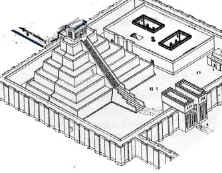 Ur-Gur
gave to the temple its final characteristic form. Partly razing the
constructions of his predecessors, he erected a terrace of bricks, some
12 m high, covering a space of about 32,000 m�, near the north-western
edge of which, towards the western corner, he built a ziggurat, or
stage-tower, of three stages of dry brick, faced with kiln-fired bricks
laid in bitumen. On the summit of this artificial mountain stood,
apparently, as at Ur and Eridu, a small chamber, the special shrine or
abode of the god. Access to the stages of the ziggurat, from the court
beneath, was had by an inclined plane on the south-east side. To the
north-east of the ziggurat stood, apparently, the House of Bel, and in
the courts below the ziggurat stood various other buildings, shrines,
treasure chambers and the like. The whole structure was roughly
oriented, with the corners towards the cardinal points of the compass. Ur-Gur
gave to the temple its final characteristic form. Partly razing the
constructions of his predecessors, he erected a terrace of bricks, some
12 m high, covering a space of about 32,000 m�, near the north-western
edge of which, towards the western corner, he built a ziggurat, or
stage-tower, of three stages of dry brick, faced with kiln-fired bricks
laid in bitumen. On the summit of this artificial mountain stood,
apparently, as at Ur and Eridu, a small chamber, the special shrine or
abode of the god. Access to the stages of the ziggurat, from the court
beneath, was had by an inclined plane on the south-east side. To the
north-east of the ziggurat stood, apparently, the House of Bel, and in
the courts below the ziggurat stood various other buildings, shrines,
treasure chambers and the like. The whole structure was roughly
oriented, with the corners towards the cardinal points of the compass.
(More about Ziggurats)
The Geographical location of Nippur places it
approximately 2 �
North and 14� East of the Giza/Heliopolis complex, an 'anchor point'
from which several other important ancient sites were geodetically
positioned such as Nimrud, Persopolis, Khorsabad, Baalbek.
(Click here for more
about Prehistoric Geodesy) |
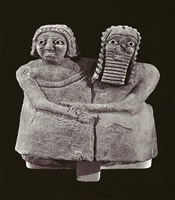
Other Discoveries at Nippur.
A devotional statue
dating to 2600 B.C. of what scholars believe is a married couple. The
gypsum statue was found buried beneath the floor of a shine at Nippur in
Iraq and measures 3.5 inches wide at the bottom. The couple originally
had feet, and the figures have eyes made of shell and lapis lazuli set
in bitumen.
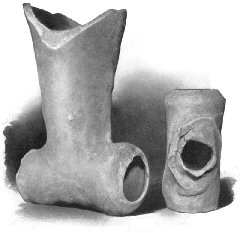
Plumbing:
Knee and T-joints made about 4,000
B.C. Found in the excavation of the Temple of Bel at Nippur, Babylonia.
Pipe was made of baked clay. Babylonia is often referred to as the
birthplace of pipe.
Source: Cast
Iron Pipe, Standard Specifications Dimensions and Weights
(Burlington, New Jersey: United States Cast Iron Pipe & Foundry
Co.,1914), p. 13.
(Other
Sumerian Sites)
|
|